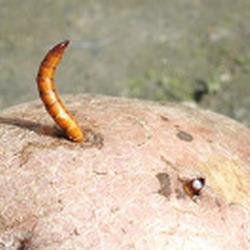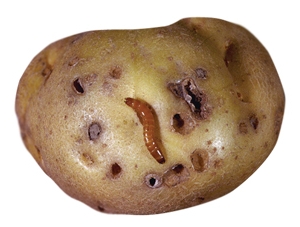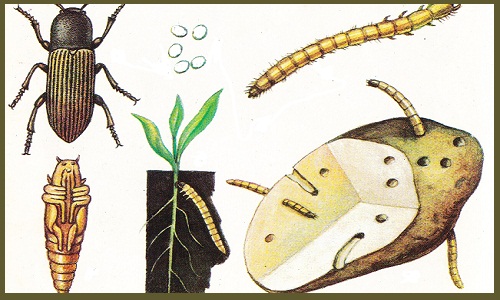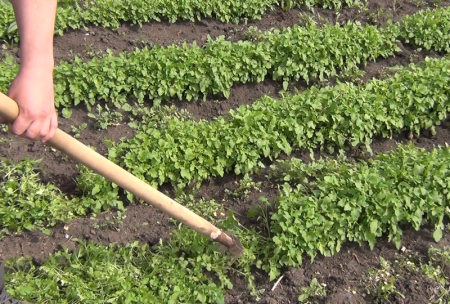 If there is a wireworm in potatoes, how every gardener should get rid of it. Because, if the pest is allowed to develop quietly and not fight it, as a result, the entire crop of potatoes, and with it other tuber crops, will be destroyed. After all, the larvae of this beetle are very voracious and live in the earth for four years until the adult phase.
If there is a wireworm in potatoes, how every gardener should get rid of it. Because, if the pest is allowed to develop quietly and not fight it, as a result, the entire crop of potatoes, and with it other tuber crops, will be destroyed. After all, the larvae of this beetle are very voracious and live in the earth for four years until the adult phase.
We must immediately warn that the fight against this pest is long. Larvae quickly adapt to new conditions and means for struggle, whether chemistry or folk broths, have to be constantly changed. In order to gain success in the war and maintain your crop in the end, you should get the most information on the topic.
Content
About wireworm
If wireworm settled (see photo and description), then how to fight it will be possible to understand only after a close acquaintance with the pest. This is a small worm, which in length rarely reaches even two and a half centimeters (which, in principle, is quite large for garden pests). This parasite gets its name for the reason that it feels as hard and hard as wire. The color of the worm ranges from light yellow to a rich brown hue.
The worm is the stage of the larva until the development of the nutcracker bug. First, small eggs appear in the ground about one and a half millimeters in length. They are white, oval in shape. Soon, a wireworm emerges from the eggs and, which is extremely dangerous and annoying for gardeners, the wireworm becomes an adult beetle, which already leaves the soil, only in the fourth year of its life. An adult beetle lays eggs in the ground and flies free. That is, for all four years, wireworm larvae, if you do not fight them, will eat your potatoes and other root crops.
What the gardener should remember by reading this part of the material is that the larva does the greatest damage to potatoes and the yield of other root crops. She likes to eat wheatgrass roots, root crops, especially potatoes. Adult beetles are already sent to the surface as soon as the soil warms up, already somewhere in April or at the very beginning of May. Then the beetles hide in the moist and shady places of the site, already feed on cereal crops, overgrown grasses.

Interesting! Traditionally considered the main enemy potato colorado potato beetle. But its damage is not as noticeable as from wireworm larvae. Because wireworms are difficult to detect, unlike the Colorado potato beetle, the larvae of these pests eat potato tubers when they are still in the ground.
About wireworm detection methods
Of all the tuber crops, as noted in this material, most wireworms love to eat potatoes. Understand that the gardener and his family are not the first who will feast on the harvest, it is possible for some reasons.
Among the main signs of a defeat of potatoes with wireworms can be noted:
- Freshly dug tubers have narrow through holes, and small dark recesses of the skin are also visible during visual inspection.
- It happens that among the mostly healthy potato shrubs, affected or wilting plants appear. This may be a sign that the wireworm has begun to devour the crop. Larvae migrate perfectly in the vertical direction, but move poorly horizontally.That is, the larva is unlikely to move further than twenty centimeters from the place of feeding. For this reason, as a rule, it is detached plants that are damaged, and drying and withering of a bed or planting strip do not occur immediately.
- By chance, wireworm larvae can be dug up simply during land work in the garden. During their activity, the larvae are often located at a depth of no more than ten, and often even five centimeters. Adults are similar to ground beetles, but they have a characteristic click that they emit (to hear a click, an adult beetle must be turned from the back to the abdomen).

What is the danger of wireworm for potatoes
When the wireworm appeared in potatoes, you need to know thoroughly how to get rid of in the fall or at another time of the year. But even before moving on to any specific methods of getting rid of the pest, it is necessary to discuss once again what exactly it is dangerous for the crop.
It must be understood that if the site is infected with larvae up to 3 cm in length, more than 60% of potato tubers, if no measures are taken, will be affected. Movements will be digged in the potato and root crops will no longer be suitable for eating.
While the damaged potato is still in the soil and the gardener does not suspect this, the likelihood of developing putrefactive bacteria, nematodes and mushrooms in the pulp of the damaged tuber grows. The wireworm can also eat juicy roots, which means that even undamaged tubers will not receive nutrition and the yield of the bushes will sharply and noticeably decrease.
The habitat of wireworms is extremely extensive, roughly speaking, they can be found everywhere. They eat not only potato tubers, but also root crops of carrots and beets, they do not shun the roots of wheatgrass, bluegrass. But potato plantations are attractive to the larvae precisely because there is always a lot of juicy food. The pest is active during the entire vegetation period of the plant, and often such activity without control measures by the gardener leads, of course, to drying of the bushes.

How to get rid of wireworm
It is immediately worth noting that folk remedies will only partially help in how to get rid of wireworms in potatoes. It is important to carry out comprehensive measures and not to forget about prevention. To fight to be successful, you need to immediately in several areas.
Of the main areas for combating the voracious beetle larva, spring tillage should be noted. Need to fertilize from pests. You will also need to set traps and baits on the site, not only for larvae, but also for adult beetles. Potato tubers themselves are recommended to be treated with active substances before planting. Mandatory attention should be paid to mechanical weeding and loosening of the soil during the growing season.
About preventive measures that must be followed necessarily and always:
- Crop rotation. This means that one and the same plot cannot be allocated for potatoes from year to year. Because, this will lead not only to the development of larvae, but to crop failure and because of a violation of an important agricultural technology rule.
- It is necessary to kill the ripened crop on time, in no case leave root crops in the ground for the winter. This will eliminate the source of both food and heat for the wireworm. That is, the larvae can no longer afford to winter on your site with comfort.
- It is imperative that measures be taken to reduce the acidity of the soil. Indicator plants, such as sorrel, plantain, or field horsetail, are natural signals that the soil in the garden has become very acidic.
- It is worth remembering that the larvae and beetle have natural enemies, they can be attracted to the site. For example, these are birds (starling, crow, rook, tit).How to attract birds to your site? Build a birdhouse, this is a useful and necessary thing!
- Also among the natural enemies of the wireworm, ground beetles can be noted. These are insects, but they are carnivorous and eat bugs with pleasure.
- Burdock and wheatgrass on the site is an excellent house for larvae, so such weeds must be removed from the site first.
- You can plant siderata plants that will scare off wireworms only with their smell. For example, mustard will definitely help in how to get rid of wireworms in potatoes. Mustard planted in the fall, you need to wait for it to grow by 10 cm and cut, then close it up for the winter in the ground. Repeat the operation in early spring. A rotting plant releases an essential oil that repels the pest in question.
- To the siderat plants for controlling wireworms in potatoes are colza, rape and marigolds, spinach, clover and even buckwheat.
- Bean crops next to potatoes can also be planted, for some reason the larvae of this beetle do not like peas, beans and all kinds of beans. Such plants and the site will benefit, enriching the soil with nitrogen.
- And the wireworm does not tolerate the aroma of beautiful dahlias. Also, wheatgrass does not grow near these flowers, the roots of which are an excellent environment for the life of harmful larvae.

Potato Processing with Prestige
Mild chemistry will help in how to get rid of wireworms in potatoes. In particular, tubers can be protected from attack by treating them before planting with the active substance Prestige. After planting, the potato will lose its attractiveness for the pest, by the way, not only for the wireworm, but also for the bear, the Colorado potato beetle and the raspberry.
True, the instructions say that the effect of this drug lasts only two months. But this will be enough to have the first leaves already appear on the bed and you can observe how the Colorado potato beetle responds. To test the reaction of wireworm larvae, it will be necessary to dig in the bushes as they grow and bloom. However, after two months, the potatoes are again unprotected and pests will actively rush to young potatoes.
Interesting! Tubers for winter storage of potatoes are dug up on average two months later. In this situation, gardeners must take measures to protect themselves from the pest. Early varieties of potatoes will be reliably protected by chemistry for exactly two months, and then you can dig out the crop and eat it.
Other methods of getting rid of wireworm in potatoes:
- Be sure to dig up the site in early spring, then the larvae and adult beetles are inactive and will become easy prey for birds, they will die in the sun.
- Remove weeds and roots because they become a great home for wireworms.
- In the summer, it is imperative to loosen the soil between the potato bushes. This will help to remove the eggs.
- Shortly before frost in the fall, you must dig a plot. This will remove insects into the air, where they will die from frost.
- In the spring, add fertilizers containing nitrogen and ammonia to the soil. For wireworm, these fertilizers are unpleasant. Also, the pest does not like soils with low acidity.
- When planting potatoes, you can add several granules of superphosphate to the wells.
- You can add a little special soil to the holes when planting potatoes, which contains predatory nematodes. These microscopic worms are predators and will actively feed on beetle larvae. Moreover, for potatoes and humans, nematodes are safe.





 Description and description of varieties in Belarus with a photo
Description and description of varieties in Belarus with a photo Do I need to pick flowers from potatoes: why do they do it
Do I need to pick flowers from potatoes: why do they do it When to dig potatoes: timing and availability of new potatoes
When to dig potatoes: timing and availability of new potatoes How to grow a good potato crop: various methods and methods, planting and care
How to grow a good potato crop: various methods and methods, planting and care